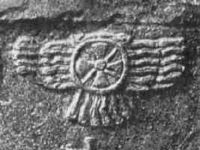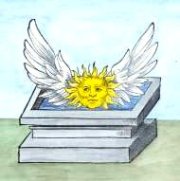
Winged sun
Encyclopedia

Divinity
Divinity and divine are broadly applied but loosely defined terms, used variously within different faiths and belief systems — and even by different individuals within a given faith — to refer to some transcendent or transcendental power or deity, or its attributes or manifestations in...
, royalty
Royal family
A royal family is the extended family of a king or queen regnant. The term imperial family appropriately describes the extended family of an emperor or empress, while the terms "ducal family", "grand ducal family" or "princely family" are more appropriate to describe the relatives of a reigning...
and power in the Ancient Near East
Ancient Near East
The ancient Near East was the home of early civilizations within a region roughly corresponding to the modern Middle East: Mesopotamia , ancient Egypt, ancient Iran The ancient Near East was the home of early civilizations within a region roughly corresponding to the modern Middle East: Mesopotamia...
(Egypt
Ancient Egypt
Ancient Egypt was an ancient civilization of Northeastern Africa, concentrated along the lower reaches of the Nile River in what is now the modern country of Egypt. Egyptian civilization coalesced around 3150 BC with the political unification of Upper and Lower Egypt under the first pharaoh...
, Mesopotamia
Mesopotamia
Mesopotamia is a toponym for the area of the Tigris–Euphrates river system, largely corresponding to modern-day Iraq, northeastern Syria, southeastern Turkey and southwestern Iran.Widely considered to be the cradle of civilization, Bronze Age Mesopotamia included Sumer and the...
, Anatolia
Anatolia
Anatolia is a geographic and historical term denoting the westernmost protrusion of Asia, comprising the majority of the Republic of Turkey...
, and Persia). The symbol has also been found in the records of ancient cultures residing in various regions of South America
South America
South America is a continent situated in the Western Hemisphere, mostly in the Southern Hemisphere, with a relatively small portion in the Northern Hemisphere. The continent is also considered a subcontinent of the Americas. It is bordered on the west by the Pacific Ocean and on the north and east...
as well as Australia
Australia
Australia , officially the Commonwealth of Australia, is a country in the Southern Hemisphere comprising the mainland of the Australian continent, the island of Tasmania, and numerous smaller islands in the Indian and Pacific Oceans. It is the world's sixth-largest country by total area...
.
Ancient Egyptian use
In Ancient Egypt, the symbol is attested from the Old KingdomOld Kingdom
Old Kingdom is the name given to the period in the 3rd millennium BC when Egypt attained its first continuous peak of civilization in complexity and achievement – the first of three so-called "Kingdom" periods, which mark the high points of civilization in the lower Nile Valley .The term itself was...
(Sneferu
Sneferu
Sneferu, also spelled as Snephru, Snefru or Snofru , was the founder of the Fourth dynasty of Egypt. Estimates of his reign vary, with for instance The Oxford History of Ancient Egypt suggesting a reign from around 2613 BC to 2589 BC, a reign of 24 years, while Rolf Krauss suggests a 30-year reign...
, 26th century BC), often flanked on either side with a uraeus
Uraeus
The Uraeus is the stylized, upright form of an Egyptian spitting cobra , used as a symbol of sovereignty, royalty, deity, and divine authority in ancient Egypt.The Uraeus is a symbol for the goddess Wadjet, who was one of the earliest Egyptian deities and who...
.
In early Egyptian religion, the symbol Behedeti represented Horus
Horus
Horus is one of the oldest and most significant deities in the Ancient Egyptian religion, who was worshipped from at least the late Predynastic period through to Greco-Roman times. Different forms of Horus are recorded in history and these are treated as distinct gods by Egyptologists...
of Edfu
Edfu
Edfu is an Egyptian city, located on the west bank of the Nile River between Esna and Aswan, with a population of approximately sixty thousand people. For the ancient history of the city, see below...
, later identified with Ra-Harachte. It is sometimes depicted on the neck of Apis
Apis (Egyptian mythology)
In Egyptian mythology, Apis or Hapis , was a bull-deity worshipped in the Memphis region.According to Manetho, his worship was instituted by Kaiechos of the Second Dynasty. Hape is named on very early monuments, but little is known of the divine animal before the New Kingdom...
, the bull of Ptah
Ptah
In Ancient Egyptian Religion, Ptah was the deification of the primordial mound in the Ennead cosmogony, which was more literally referred to as Ta-tenen , meaning risen land, or as Tanen, meaning submerged land, though Tatenen was a god in his...
. As time passed (according to interpretation) all of the subordinated gods of Egypt were considered to be aspects of the sun god, including e.g. Khepri
Khepri
This article is about the Egyptian god. For the type of robot, see Khepera mobile robot.In Egyptian mythology, Khepri is the name of a major god. Khepri is associated with the dung beetle , whose behavior of maintaining spherical balls of dung represents the forces which move the sun...
.
Mesopotamia and the Levant


Levant
The Levant or ) is the geographic region and culture zone of the "eastern Mediterranean littoral between Anatolia and Egypt" . The Levant includes most of modern Lebanon, Syria, Jordan, Israel, the Palestinian territories, and sometimes parts of Turkey and Iraq, and corresponds roughly to the...
and to Mesopotamia
Mesopotamia
Mesopotamia is a toponym for the area of the Tigris–Euphrates river system, largely corresponding to modern-day Iraq, northeastern Syria, southeastern Turkey and southwestern Iran.Widely considered to be the cradle of civilization, Bronze Age Mesopotamia included Sumer and the...
. It appears in reliefs with Assyria
Assyria
Assyria was a Semitic Akkadian kingdom, extant as a nation state from the mid–23rd century BC to 608 BC centred on the Upper Tigris river, in northern Mesopotamia , that came to rule regional empires a number of times through history. It was named for its original capital, the ancient city of Assur...
n rulers and in Hieroglyphic Anatolian
Hieroglyphic Luwian
Hieroglyphic Luwian is a variant of the Luwian language, recorded in official and royal seals and a small number of monumental inscriptions. It is written in a hieroglyphic script known as Anatolian hieroglyphs...
as a symbol for royalty, transcribed as SOL SUUS (literally, "his own self, the Sun", i.e., "His Majesty").
Hebrew
From ca. the 8th century BC, it appears on HebrewHebrews
Hebrews is an ethnonym used in the Hebrew Bible...
seals, by now as a generic symbol for "power". One example is a seal where the winged sun is flanked by two Ankh
Ankh
The ankh , also known as key of life, the key of the Nile or crux ansata, was the ancient Egyptian hieroglyphic character that read "eternal life", a triliteral sign for the consonants ʻ-n-ḫ...
symbols and a Hebrew
Hebrew language
Hebrew is a Semitic language of the Afroasiatic language family. Culturally, is it considered by Jews and other religious groups as the language of the Jewish people, though other Jewish languages had originated among diaspora Jews, and the Hebrew language is also used by non-Jewish groups, such...
inscription translating to "possession of Hezekiah
Hezekiah
Hezekiah was the son of Ahaz and the 14th king of Judah. Edwin Thiele has concluded that his reign was between c. 715 and 686 BC. He is also one of the most prominent kings of Judah mentioned in the Hebrew Bible....
, son of Ahaz
Ahaz
Ahaz was king of Judah, and the son and successor of Jotham. He is one of the kings mentioned in the genealogy of Jesus in the Gospel of Matthew....
, king of Juda
Kingdom of Judah
The Kingdom of Judah was a Jewish state established in the Southern Levant during the Iron Age. It is often referred to as the "Southern Kingdom" to distinguish it from the northern Kingdom of Israel....
". Numerous pottery finds dating to the same time bear the symbol together with the inscription lemelekh "king's [property]".
Compare also Malachi
Malachi
Malachi, Malachias or Mal'achi was a Jewish prophet in the Hebrew Bible. He had two brothers, Nathaniel and Josiah. Malachi was the writer of the Book of Malachi, the last book of the Neviim section in the Jewish Tanakh...
4:2, referring to a winged "Sun of righteousness",
- But unto you that fear my name shall the Sun of righteousness arise with healing in his wings... (KJV)
Zoroastrianism
The symbol evolved into the FaravaharFaravahar
Faravahar is one of the best-known symbols of Zoroastrianism, the state religion of ancient Iran. This religious-cultural symbol was adapted by the Pahlavi dynasty to represent the Iranian nation....
(the "visual aspect of Ahura Mazda
Ahura Mazda
Ahura Mazdā is the Avestan name for a divinity of the Old Iranian religion who was proclaimed the uncreated God by Zoroaster, the founder of Zoroastrianism...
") in Zoroastrian Persia.
Modern use

Charles Taze Russell
Charles Taze Russell , or Pastor Russell, was a prominent early 20th century Christian restorationist minister from Pittsburgh, Pennsylvania, USA, and founder of what is now known as the Bible Student movement, from which Jehovah's Witnesses and numerous independent Bible Student groups emerged...
's textbook series Studies in the Scriptures
Studies in the Scriptures
Studies in the Scriptures is a series of publications, intended as a Bible study aid, containing seven volumes of great importance to the history of the Bible Students, and the early history of the Jehovah's Witnesses.-Origin and author:...
beginning with the 1911 editions. Various groups such as Freemasonry
Freemasonry
Freemasonry is a fraternal organisation that arose from obscure origins in the late 16th to early 17th century. Freemasonry now exists in various forms all over the world, with a membership estimated at around six million, including approximately 150,000 under the jurisdictions of the Grand Lodge...
, Theosophy
Theosophy
Theosophy, in its modern presentation, is a spiritual philosophy developed since the late 19th century. Its major themes were originally described mainly by Helena Blavatsky , co-founder of the Theosophical Society...
, Rosicrucians and Unity Church
Unity Church
Unity, known informally as Unity Church, is a religious movement within the wider New Thought movement and is best known to many through its Daily Word devotional publication...
have also used it. Variations of the symbol are used as a trademark logo on vehicles produced by the Chrysler
Chrysler
Chrysler Group LLC is a multinational automaker headquartered in Auburn Hills, Michigan, USA. Chrysler was first organized as the Chrysler Corporation in 1925....
Corporation, and Harley Davidson.
Literature
- R. Mayer, Opificius, Die geflügelte Sonne, Himmels- und Regendarstellungen im Alten Vorderasien, UF 16 (1984) 189-236.
- D. Parayre, Carchemish entre Anatolie et Syrie à travers l'image du disque solaire ailé (ca. 1800-717 av. J.-C.), Hethitica 8 (1987) 319-360.
- D. Parayre, Les cachets ouest-sémitiques à travers l'image du disque solaire ailé, Syria 67 (1990) 269-314.
External links
- The Winged Sun Disk
- Panel with a male figure grasping a tree; winged sun disc above, Neo-Assyrian; 8th century BC
- Relief Depicting Gilgamesh Between Two Bull-Men Supporting a Winged Sun Disk, KaparaKaparaKing Kapara of Guzana was the ruler of a small Aramaean kingdom of Bit Bahiani in the 10th or 9th century BC...
palace, Tell HalafTell HalafTell Halaf is an archaeological site in the Al Hasakah governorate of northeastern Syria, near the Turkish border, just opposite Ceylanpınar. It was the first find of a Neolithic culture, subsequently dubbed the Halaf culture, characterized by glazed pottery painted with geometric and animal designs...
. - Charles T. Russell's use of winged disk

